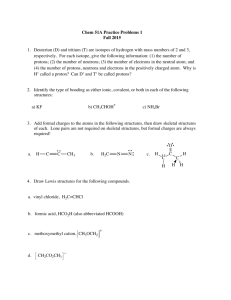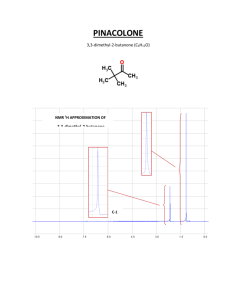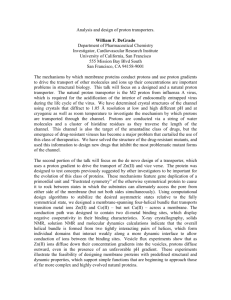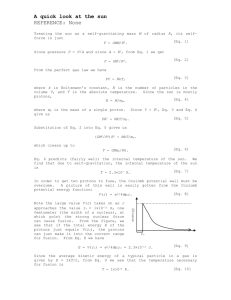1H NMR - INTEC Chemistry Blog
advertisement
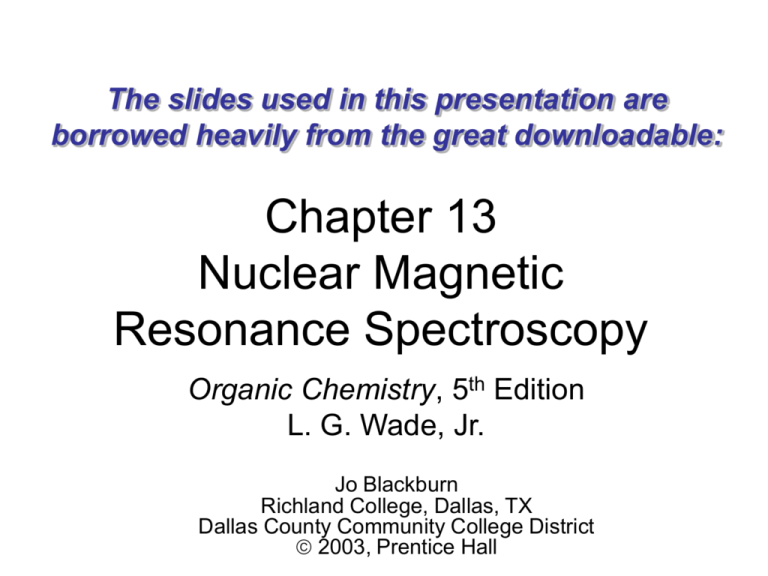
The slides used in this presentation are borrowed heavily from the great downloadable: Chapter 13 Nuclear Magnetic Resonance Spectroscopy Organic Chemistry, 5th Edition L. G. Wade, Jr. Jo Blackburn Richland College, Dallas, TX Dallas County Community College District 2003, Prentice Hall 1H NMR 1 GHz machine in France! 4 Essential points Re: NMR 1. Number of peaks = No of H environments (a peak may be split into many smaller peaks) 2. Position of the peak depends of ‘chemical’ (actually magnetic) environment. 3. Area under the peak = relative number of H in that chemical environment 4. Splitting patters reveals info about adjacent H’s The NMR Spectrometer => The NMR Graph => CH3 H3C Si CH3 Tetramethylsilane CH3 • TMS is added to the sample. • Since silicon is less electronegative than carbon, TMS protons are highly shielded. Signal defined as zero. • Organic protons absorb downfield (to the left) of the TMS signal. => Number of Signals Equivalent hydrogens have the same chemical shift. Each H in the methyl group at ‘a’ are equivalent to each other. (etc) => Location of Signals - deshielding • More electronegative atoms deshield more and give larger shift values. • Effect decreases with distance. • Additional electronegative atoms cause increase in chemical shift. => This slide basically says peak position is independent of electromagnetic frequency Delta Scale OLD MACHINE NEWER MACHINE => Typical Values => Ethanol Aromatic Protons, 7-8 => Vinyl Protons, 5-6 => Acetylenic Protons, 2.5 => Aldehyde Proton, 9-10 Electronegative oxygen atom => Carboxylic Acid Proton, 10+ => O-H and N-H Signals • Chemical shift depends on concentration. • Hydrogen bonding in concentrated solutions deshield the protons, so signal is around 3.5 for N-H and 4.5 for O-H. • Proton exchanges between the molecules broaden the peak. => Intensity of Signals • The area under each peak is proportional to the number of protons. • Shown by integral trace. => • Flv Video: Instrumentation How Many Hydrogens? When the molecular formula is known, each integral rise can be assigned to a particular number of hydrogens. => Spin-Spin Splitting • Nonequivalent protons on adjacent carbons have magnetic fields that may align with or oppose the external field. • This magnetic coupling causes the proton to absorb slightly downfield when the external field is reinforced and slightly upfield when the external field is opposed. • All possibilities exist, so signal is split. => Range of Magnetic Coupling • Protons on adjacent carbons normally will couple. • Equivalent protons do not split each other. • Protons separated by four or more bonds will not couple. • Protons bonded to the same carbon will split each other only if they are not equivalent. (e.g CH2 next to a C*-H) => Simple spectra Stolen from http://www.organicchemistryreview.com/spectroscopy.html Stolen from http://www.organicchemistryreview.com/spectroscopy.html Doublet: 1 Adjacent Proton => Triplet: 2 Adjacent Protons => No splitting – no adjacent H 1,1,2-Tribromoethane Nonequivalent protons on adjacent carbons. => ethanol The N + 1 Rule If a signal is split by N equivalent protons, it is split into N + 1 peaks. => Pascal's triangle Helps you interpret the splitting Pattern. OR gives the splitting pattern (prediction) http://www.lincoln.k12.nv.us/alamo/high/Departments/Math/Pascal/Pascal's_Triangle_Webquest.html Splitting for Ethyl Groups => Splitting for Isopropyl Groups => http://www.absoluteastronomy.com/topics/Proton_NMR Double bond equivalents • Satd organic molecule has 2n+2 H’s for every C. • Each double bond ‘takes 2 H away’ No H’s =2n e.g. ethene C2H4 • A ring also ‘takes 2 H’s away’ cyclehexane C6H12 From molecular formula… • • • • • • For every halogen, add 1 H For every N take away 1 H For every O, do nothing. Ethanol = C2H5OH =>C2H6 Compare it to satd formula for 2C’s No difference therefore molecule C2H5OH has no double bond equivalents. Ethanal = ? Methylbenzene = ? • MRI • Dangers of MRI Functional group region >1400 cm-1 Stolen from http://www.organicchemistryreview.com/spectroscopy.html Answer? Sure? 2-methylpropan-1-ol http://science.widener.edu/svb/nmr/seminar/isobutanol.html Quiz High Performance (High Pressure) Liquid Chromatography (HPLC) HPLC schematic http://www.idex-hs.com/support/upchurch/i/hplcDiagram.gif http://www.goehler-hplc.de/images/parts.jpg The column High Performance Liquid Chromatography (HPLC) (High Pressure) High pressure gives separation much faster than say gravity based chromatography (paper or column chromatography) Detector uses UV light to detect presence of chromophores High Performance Liquid Chromatography (HPLC) (High Pressure) • Stationary phase in the form of a steel encased column (size of a straw) = silica gel, Al2O3 or C18 hydrocarbon – giving different polarities. • Mobile phase = solvent • Area under peak = measure of the relative abundance of the compound • Add a standard of known concentration to get it’s peak area. • The same species have the same retention time (if all other factors are kept constant e.g. pressure, solvent, column type) • Can separate chiral compounds Amino acids are poor at absorbing UV so they Have a UV chromophore bonded to them for the purpose of being HPLC’d UV detector set at λ=338nm http://www.biocompare.com/Articles/ApplicationNote/1508/ANALYSIS-OF-AMINO-ACIDS-BY-REVERSED-PHASECHROMATOGRAPHY-WITH-PRECOLUMN-DERIVATISATION-AND-UV-VISIBLE-DETECTION.html http://www.aldbot.com/HPLC-Hawaii.gif Sample will pass quickly through the column IF: • It has similar polarity to mobile phase • Stationary phase in the column has a large particle size. • Pressure of HPLC is increased • Temp not really a factor as HPLC tends not to have a heater added • Column is short. • IN GENERAL LONGER COLUMN TIMES ARE BETTER (GIVE BETTER SEPARATION IN MISTURES SO REVERSE THE ABOVE CONDITIONS.

